Bespoke Web Development: Full Synopsis

The scene of bespoke web development is on the rise with businesses striving to create something never before seen in order to stand out from vicious competition. On the surface, the topic may seem straightforward enough but in our summary we will uncover the main points in great detail. from purpose and process to technologies and trends.
Learning the ins and outs of this landscape will help you get on the same page with bespoke website developers to make sure your project goes smoothly and without hiccups along the way. Throughout this review, you won’t be left with lingering questions in regard on how to build a solution that will stand the test of time.
By leveraging bespoke website development, you can take your operations and performance to the next level, solving common problems and avoiding pitfalls. Our expertise as a long-standing provider is going to guide you through this complex matter and aid you in coming up on top, so let’s get started.
What is bespoke web development?
Website creation is nothing new in our ever-evolving digital world, with first ones being introduced as early as the 1990s but there is an argument to be made that nowadays web solutions are on a completely different level than they used to be. For modern businesses, web development companies in the UK and across the globe are capable of delivering projects that are fully unique to your needs and goals.
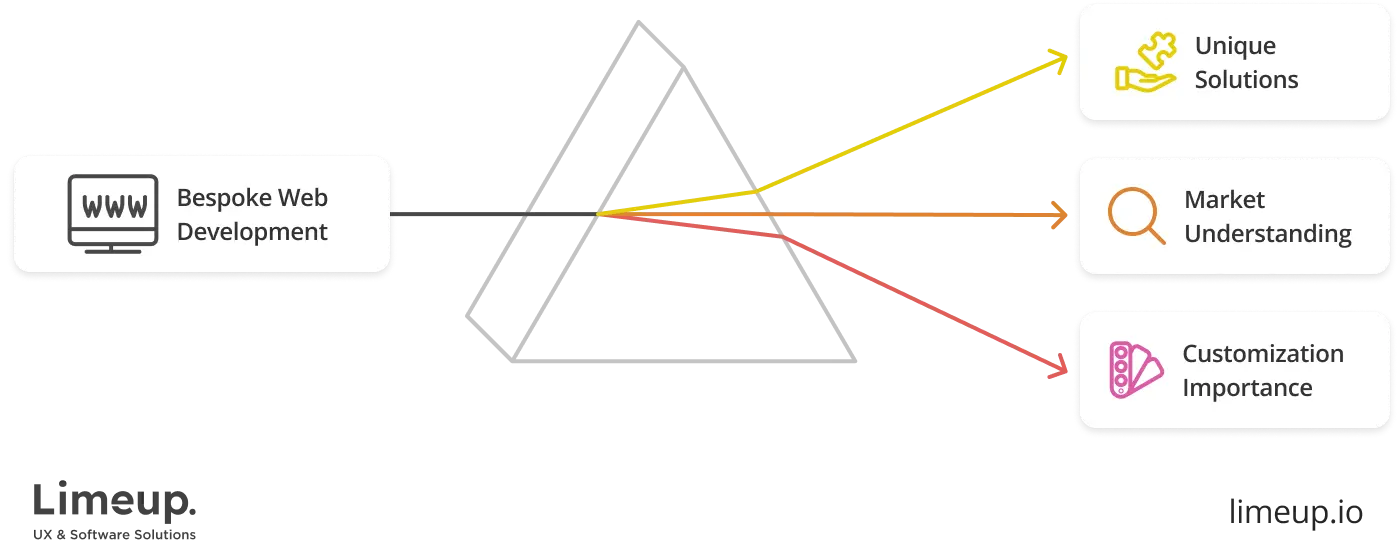
With bespoke web design and development, brands have no need to worry that some aspects of their solution may resemble others or lack in creative ideas since this type of website building offers an unparalleled level of customization. Every feature, nook and cranny can be put together from the ground up, carefully curating each element to be tailored to represent the business in an individual and recognizable light.
Development vendors possess years of training and real-world experience with specific tools, skills and industry insights to make a website that can stand strong against competition. Essentially, the purpose of bespoke web creation lies in offering a product or service that has no similar alternatives, whether in functionality or user experience.
If building a bespoke website is your cup of tea, then you have to be armed to the teeth with an understanding of how such a process unfolds, what technologies lie in its foundation and what market demands you can capitalize on to boost your likability. And we are here to tell you all about it.
The process of developing bespoke website
Getting down to business with building your own website is encapsulated in a few of the general steps of the process that you are likely to go through just like most clients in this situation. So, what does the progress look like? Let’s outline it below.
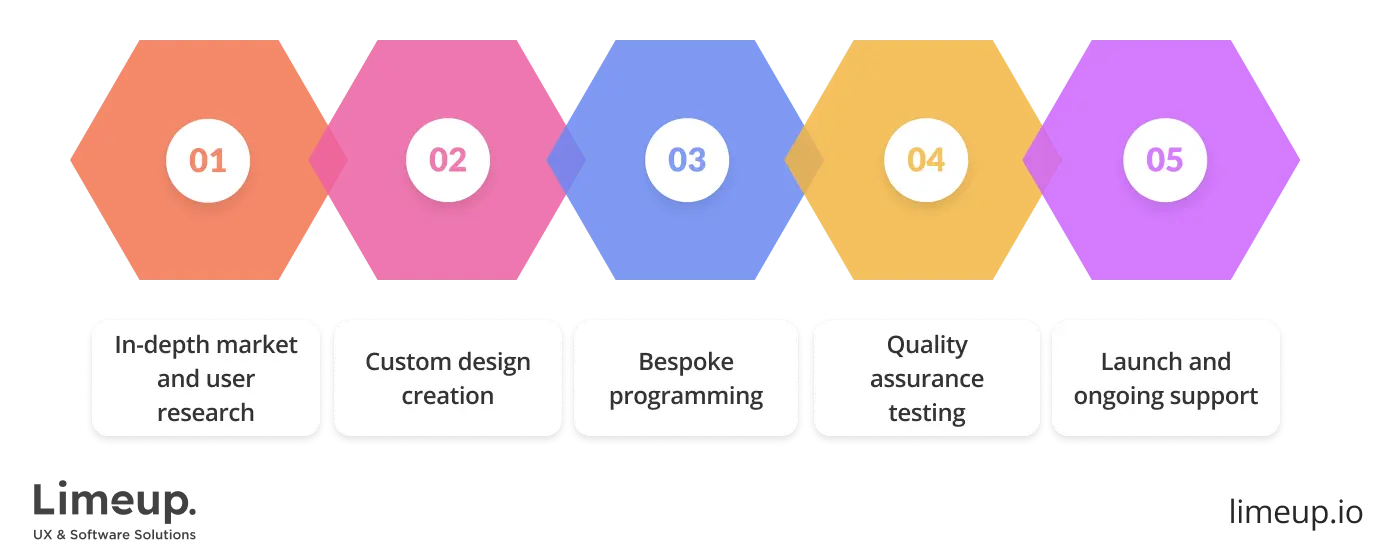
- In-depth market and user research.
After completing your consultation and signing an agreement with a provider, the technical and analytical team will jump straight into the research stage. This is where the specialists are going to handle market analysis to uncover gaps in demands that you could fill as well as competitor assessment to figure out their strong and weak points you can weaponize.
On top of that, extensive user research is going to be underway in order to define your target audience, what pain points they face, what their expectations are and how your solution can adequately address them. In the end, you will receive a comprehensive strategy and project plan that will serve as a blueprint for future development.
- Custom design creation.
No bespoke website development process is complete without crafting and implementing a consistent and pleasant design. During this phase, the research findings will be used to handcraft the wireframes and prototypes of the design based on what users will resonate with the most, as well as your own unique requirements.
Besides developing the bells and whistles of the user interface, the creative team is also going to tackle the user experience, putting together an intuitive information architecture that enables smooth navigation and makes sure the user flows are seamless, leaving no room for confusion when interacting with the website.
- Bespoke programming.
With the design being ready to get incorporated into the solution, the developers are going to proceed with writing code for the functionalities and features you want present on the site. Whether you want a CMS, eCommerce solutions, third-party integrations or anything else, this is the stage where the magic happens and it is usually marked as the most time-consuming one.
Engineering experts will pick out the necessary tech stack that will be suitable for your desires to get started (don’t worry, we will touch on this topic more later in this synopsis). A solid provider will keep you in the loop and provide demos once specific phases and sprints have been completed for your approval.
- Quality assurance testing.
With your website being fully coded and operational, the team will move forward with the next step of creating a bespoke website — ensuring the quality is up to the standard. Testing is absolutely necessary when putting together a web solution because this is where you guarantee that no bugs or errors and present within the code.
There are a variety of QA tests to be done, from unit and integration testing to performance and compatibility testing, with some options being manual or fully automated. Identifying and eliminating faults in the program is the only viable way to make sure the website performs as intended without disruptions.
- Launch and ongoing support.
The release of your web solution is marked by the completion of all of the previous stages and after thorough testing has confirmed stable and secure operation. Your website will be transferred to the production environments where users can freely access and use it, getting the full scope of benefits and functions you provided them with.
However, it should be mentioned that while your development process is over, the work doesn’t stop there as you will need to keep your solution in tip-top shape over the years to come. Ideally, you want a dedicated team for support and maintenance down the line to allow for consistent monitoring and introduction of patch updates when the need calls for it.
What technology stack is needed for bespoke website development?
The tech stack is an essential part of developing any kind of website since it acts as a construction block for the entire process. Just like you can’t put up a building without bricks, you can’t create a site without an appropriate and compatible technology stack.
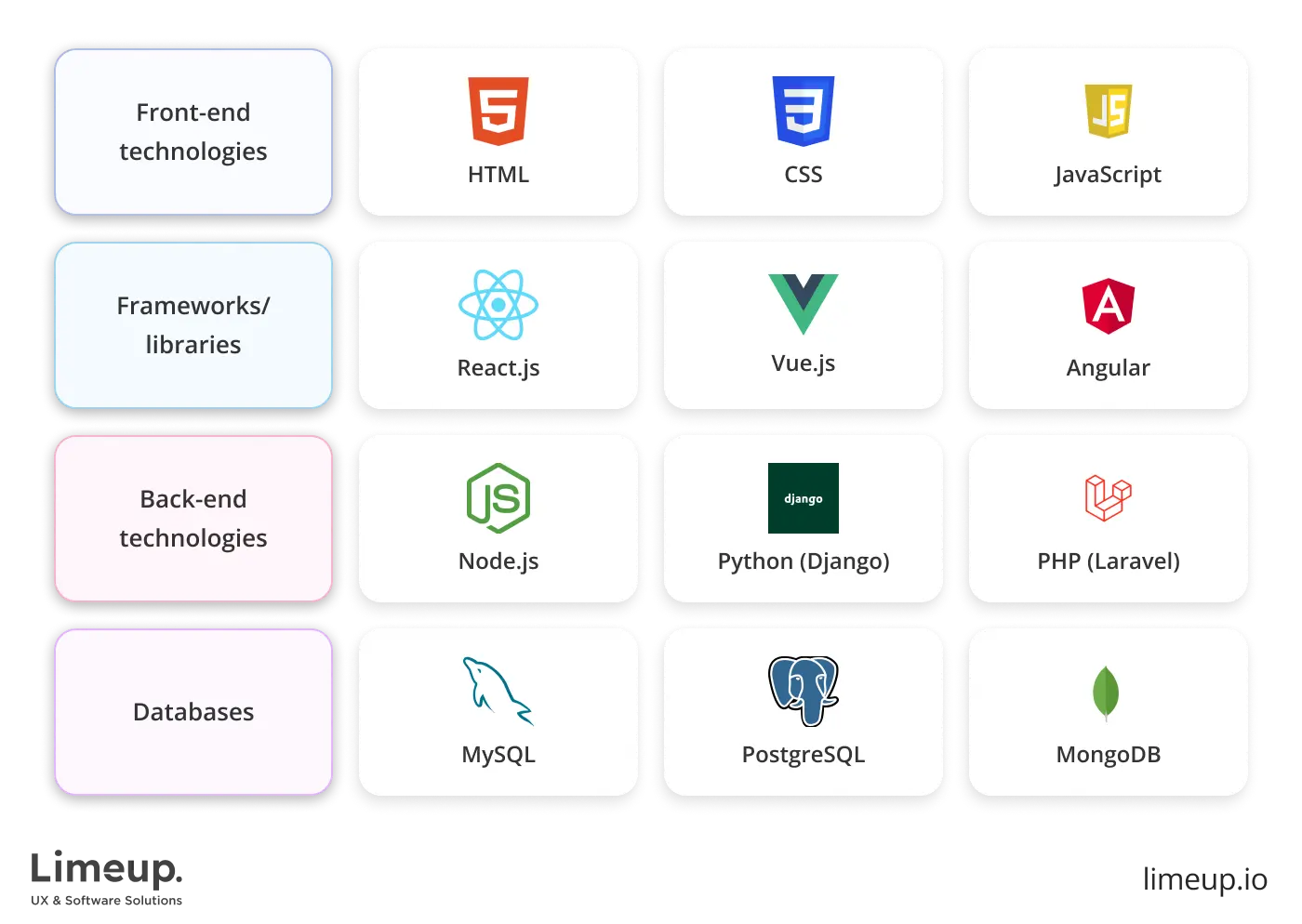
So, can you use any tools and languages to craft a solution? The short answer is no because each piece of the puzzle must work together, both on the front-end and on the back-end. Let’s get a more detailed look at each of these sides and what options are available to comprise them.
Bespoke web developers work on the front-end of the website to create what essentially is the side that customers see. Meaning its interface, interactivity and so on, using a specific set of technologies that suit the needs of the project best. Here are some of the popular varieties for your disposal.
Tools/languages:
| HTML | CSS | JavaScript |
| HTML (Hypertext Markup Language) is used to structure the website. It is considered to be the most popular technology in web development as cited by Statista in 2022. | CSS (Cascading Style Sheets) is responsible for displaying the style of data on the website, including the fonts, colors, sizes as well as other static elements. It is the second most popular tool used by developers. | JavaScript’s purpose lies in creating dynamic and interactive elements on the website that make up the user experience and ensuring it is intuitive and easy to use. |
Frameworks/libraries:
| React.js | Vue.js | Angular |
| Launched by Facebook in 2013, React is an open-source front-end library that gained popularity among technical professionals for its ability to create interfaces using components. | Vue.js is a progressive framework that is utilized in the creation of user interfaces and single-page applications. It is renowned for its flexibility and ease of integration. | In 2010, Google released the first version of Angular, a framework that would later rise in popularity as an option for building dynamic single-page apps, known for its simplicity and scalability. |
Aside from the front-end, in order to create a bespoke website the back-end needs to be fully functional as well. This one entails the server side of the operations, in a nutshell, what goes on behind the curtains that customers do not see. The following components are the ones that make up this portion of development.
Programming languages/frameworks:
| Node.js | Python (Django) | PHP (Laravel) |
| Node.js is meant to enable JavaScript to be running on the server side of the website. It is particularly useful for real-time application data handling and is praised for its straightforwardness. | Python is a versatile programming language that is useful in building websites no matter how complex they are. Coupled with the Django framework, it is a readable and robust language. | A perfect fit for dynamic websites, PHP found its place in a variety of solutions for its accessibility, integration with HTML and multi-functional Laravel framework. |
Databases:
| MySQL | PostgreSQL | MongoDB |
| MySQL is a relational database management system that is easy to follow and has a range of benefits for technical specialists. | PostgreSQL is a more advanced database management system that is best suited for more complicated projects and complex queries. | MongoDB refers to a NoSQL database which is fitting for large amounts of unstructured data that calls for scalability. |
Trends in web development for bespoke projects
The closing piece of information we want to equip you with has to do with the current trends that are either arising at the dawn of new technology implementation or establishing its place as the future norm of web development.
Keeping these popularities in mind when crafting your own solution and possibly considering integrating them into your project can leave a significant mark on its success as it will respond to the present needs of the market and the audiences. So, what are they?
- Progressive web apps (PWAs)
PWAs are not necessarily a new kid on the block since they were introduced in the late 2000s but nowadays are taking their rightful place in the niche. They offer the benefits of regular mobile apps like offline access, the ability to be placed on a home screen, fast loading times, etc., while still using the technologies of web creation we have talked about previously.
Taking into account that around 60% of traffic comes from mobile devices (not including tablets), being able to provide a seamless and user-friendly experience becomes the priority for businesses that want to please broader nets of customers.
- Artificial intelligence integration
You may be seeing yourself that more and more firms are looking to build a bespoke website using AI technologies or implementing them directly into the solution. It’s no wonder considering that in the last couple of years artificial intelligence has jumped by leaps and bounds, opening doors for new opportunities within web creation.
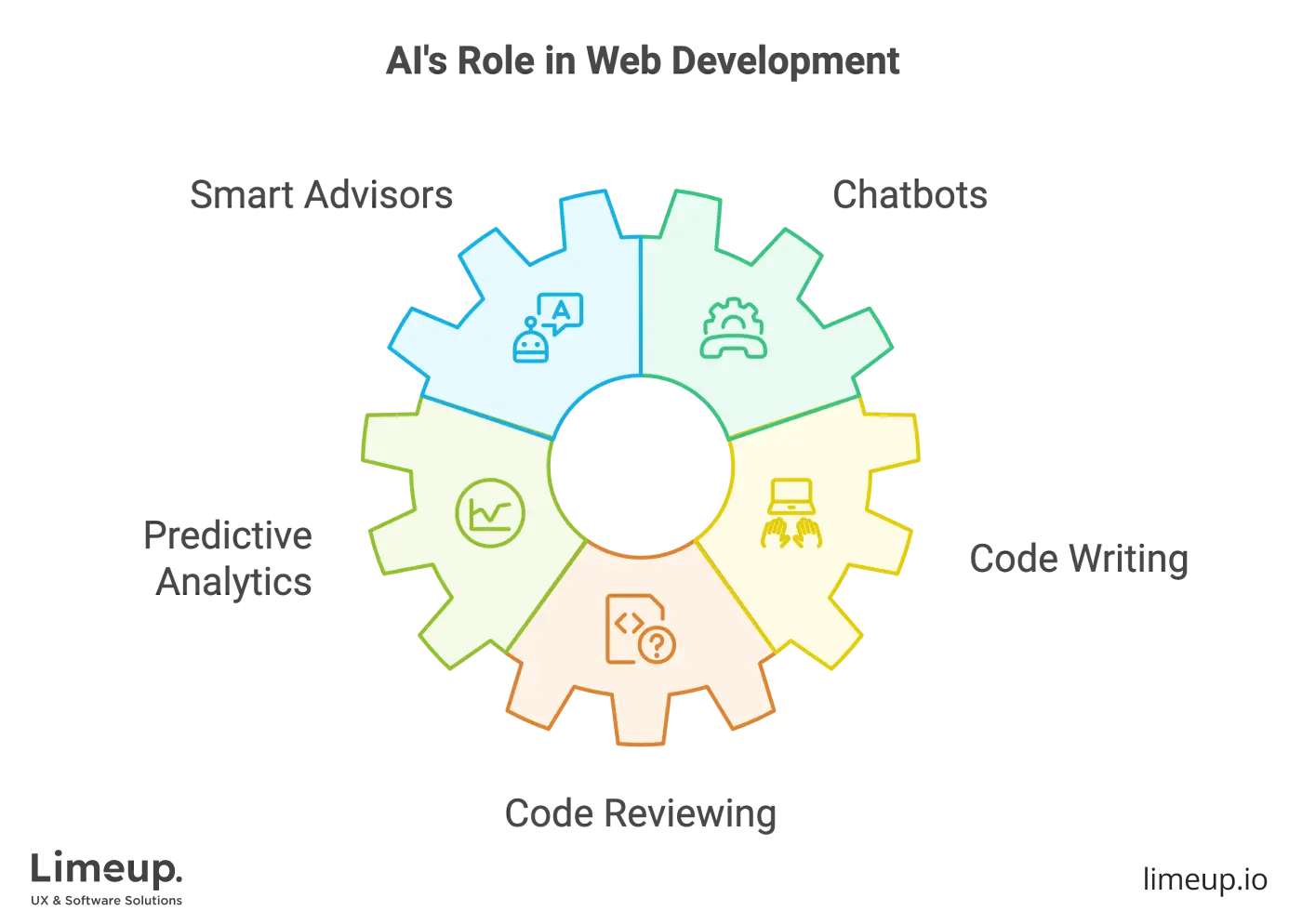
The places where you can utilize AI are seemingly boundless, from smart advisors, chatbots and predictive analytics with machine learning to writing and reviewing code, ultimately decreasing development costs and time. The lightning-fast response speed and growing accuracy of the outputs will inevitably shape the future of this sector.
- Low-code development
The demand for fast and efficient development without sacrificing quality is what brought low-code options to the table. These tools enable even non-technical staff to craft websites by leveraging drag-and-drop features, pre-made templates and other features that let you pick and choose what you want.
While low code fails to offer the full extent of customization that many businesses are striving for to stand out, this kind of development also offers a set of advantages. For example, it is ideal for the beginning stages of the project where you need to quickly validate your idea with users while keeping the building costs at a minimum.
- Serverless architecture
The last burning trend specialists offer to develop a bespoke website is making use of serverless architecture — an approach where the underlying architecture does not require manual management. In a nutshell, using cloud computing through services like AWS developers can put more time into writing code instead of worrying about server-side operations as it is handled automatically.
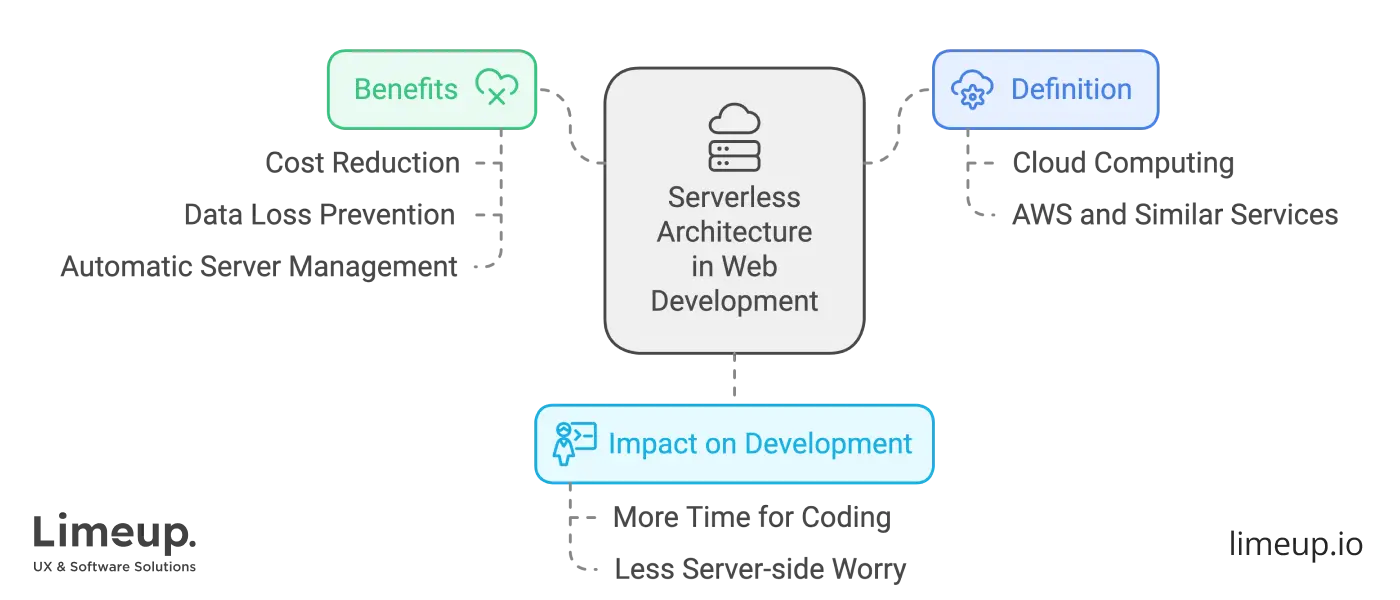
The benefits of using this method are certainly there, including cutting down the web building cost, avoiding data loss and more. These five trends are absolutely worth your attention and can be a secret sauce to the stable and enjoyable performance of your website.
Final thoughts
Every little element that makes up bespoke development is neatly connected to one another, helping you shape the best path for the progress of your project. This is why getting the hang of them is so important for businesses to steer clear of uninformed decisions that will affect the success of the website, from inside and out.
In our overview, you have been equipped with the necessary knowledge to create a bespoke website that will meet your expectations, follow the accurate journey through the development, put together an appropriate technology stack and utilize suitable trends to elevate the solution to stand strong on the market.
If you have any questions or want to contact a reliable development partner with over a decade of experience, don’t hesitate to reach out to Limeup. Our experts will consider every requirement and wish for the project to turn even the most complex of visions into reality.

